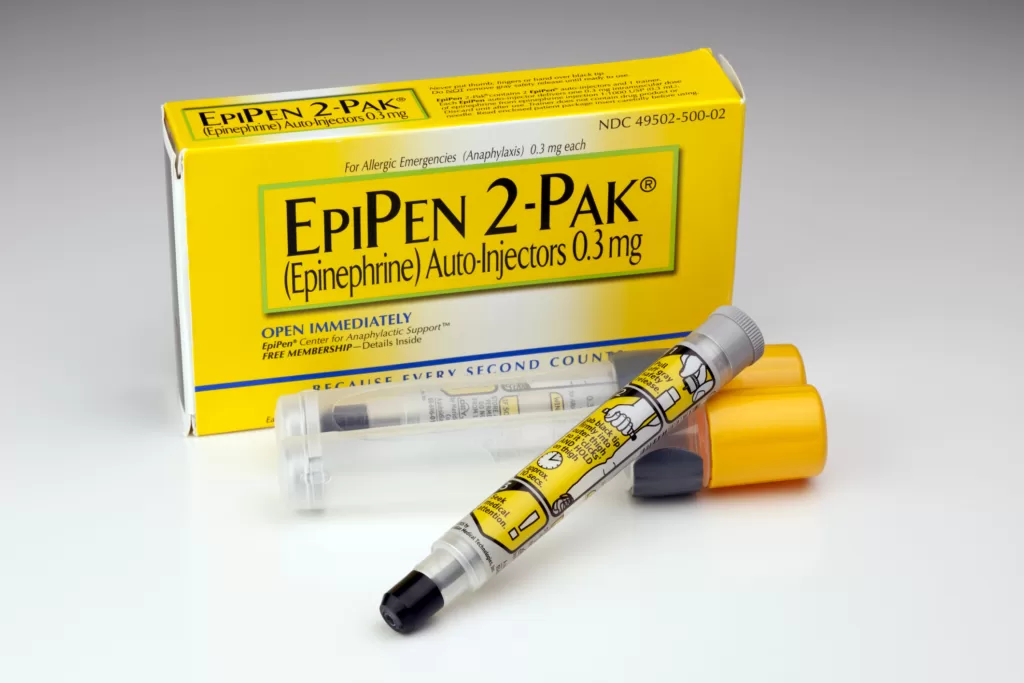Epinephrine for Dogs. Life Saving Drug
Epinephrine, also known as adrenaline, is one of the most important hormones produced by the body. In humans, it has a wide range of functions, including regulating heart rate and blood pressure in response to stress or emergencies. But did you know that epinephrine can also treat medical conditions in dogs? This blog post will discuss how veterinarians use this hormone to help pups stay healthy. From diagnosing specific disorders to alleviating symptoms caused by various underlying illnesses. Read on for essential information about how epinephrine can benefit man’s best friend.
| Brands | Epipen, Adrenaline |
| Drug Type | Anti-cholenergic |
| Species | Dogs and Cats |
| Used For | Anaphylaxis, Cardiac Resuscitation |
| Pregnancy | Don't use it in pregnancy |
| Side Effects | Tremors, Anxiety, Excitability, Vomiting, Hypertension, Arrhythmias, Hyperuricemia, Lactic acidosis |
What is Epinephrine?
- Epinephrine is a powerful hormone and neurotransmitter naturally produced in the body.
- It plays multiple roles within the body. From helping to regulate your stress response system to acting as an anti-inflammatory agent.
- It can also be administered externally in emergencies. Such as epinephrine for dogs which is available by many veterinarians.
- When given to a dog experiencing signs of severe allergen reaction or asthma attack.
- Epinephrine can quickly reduce swelling and encourage better breathing, relieving distress and saving lives.
Epinephrine Molecular Formula
C₉H₁₃NO₃

Molecular Weight
183.204 G/MOL
Forms
Available in 1:1000, 1:2000, and 1:10,000 vials and pens for injection.
Uses of Epinephrine for Dogs.
- Anaphylaxis Cardiac Resuscitation
- Epinephrine is a powerful medication that can be lifesaving for dogs with certain conditions. When used correctly, epinephrine can be administered to dogs to treat anaphylaxis, a severe allergic reaction.
- It is common for epinephrine to come in an auto-injector or epi-pen. Allowing the user to quickly and easily administer the epinephrine when needed.
- Dogs that are sensitive and prone to anaphylaxis may need epinephrine if they experience an allergic reaction.
- In some cases, epinephrine may be prescribed as a preventative measure by your veterinarian to help protect your pup from experiencing future reactions.
- If you believe that your Dog is at risk of reacting and require epinephrine. Ensure that you consult your vet so they can provide the best advice in caring for your pet.
Dosage of Epinephrine for Dogs?
Epinephrine is available in two main concentrations. 1:1,000 and 1:10,000. Keep in mind the concentrations when determining the correct dose.
Dogs, Cardiac Resuscitation. High dose (0.1-0.2 milligrams per kilogram) or low dose (0.01-0.02 milligrams per kilogram) by intravenous, intratracheal, or intraosseous injection.
Dogs, Anaphylaxis. 0.01 – 0.02 milligrams per kg by intravenous injection or 0.2-0.5 milligrams by subcutaneous or intramuscular injection.
Overdose/ Acute Toxicity:
Overdoses can be life-threatening, leading to a terrifying combination of medical conditions. From rapid increases in blood pressure and arrhythmia fluctuations through the heart to pulmonary edema which causes difficulty breathing. Furthermore, overdoses also bring on other symptoms such as vomiting and headaches. Chest pain is often present too along with cerebral hemorrhage. In some cases renal failure or metabolic acidosis may occur accompanied by cold skin – could there be anything worse?
Precautions
- Use caution in Dogs with hypovolemia.
- Use caution in Dogs with pre-fibrillatory cardiac rhythms.

How to Administer Epinephrine to a Dog?
Administering epinephrine to a dog in an emergency can be lifesaving. Following your veterinarian’s directions is key. Epinephrine ampules must be carefully dosed according to a dog’s body weight and only injected beneath the skin or into the muscle. It is important to understand that epinephrine for dogs should only be administered intramuscularly into the same area. Once every 5-7 days that epinephrine injection should never be given intravenously. Ensure you are familiar with proper epinephrine administration guidelines before administering epinephrine to your Dog.
What are the Side Effects of Epinephrine in Dogs?
Epinephrine, also known as adrenaline, to treat dogs in various circumstances. Often due to its ability to reduce inflammation and stimulate the heart. While it can be a beneficial medication for many conditions. It is important to be aware of the potential side effects that could arise with epinephrine use. These may include restlessness, increased or decreased heart rate, difficulty breathing, hypersalivation, vomiting, and trembling. Depending on the severity of these effects and other factors. Such as the Dog’s age and overall health. They could quickly become dangerous. It is important to always consult your veterinarian before administering this medication to ensure both safety and efficacy.
When should you give your Dog Epinephrine?
- Epinephrine for dogs is an injectable medication for severe allergic reactions, such as a bee sting or ingesting food allergens.
- If your Dog experiences any of these life-threatening symptoms.
- Including severe difficulty breathing, sudden vomiting, rapid swelling, and collapsing—instances where epinephrine should be administered, are clear.
- To ensure your and your pet’s safety, epinephrine is use only when necessary and if you feel comfortable administering it.
- It is important to consult with a veterinarian before using epinephrine on your canine companion.
- Depending on your pet’s needs, they can provide specific instructions on how to use epinephrine.
- Dog owners must ensure proper safety precautions. When epinephrine is present and be prepared to seek medical care for your pup if a reaction occurs.
How much does Epinephrine cost in 2023?
In the United States in 2023, epinephrine is an affordable and commonly accessible medication. It can cost as little as $20-$30 per dose, depending on the size of the drugged animal. For pet owners looking to ensure their Dog has access to epinephrine in an emergency.
Research has suggested that epinephrine can get for around $50 per dose at a standard pharmacy or veterinarian’s office. It allows pet owners peace of mind regarding their dogs’ well-being and protection.
Where can you buy Epinephrine for Dogs?
In the United States, epinephrine for dogs is typically available as an injection epinephrine auto-injector, commonly known as an epi-pen. This epi-pen, is similar to those used by people with severe allergies. Contains a single dose of epinephrine in a ready-to-use injectable form.
This can be purchased through most major pharmacies and pet stores across the country. It is usually stored behind the counter and requires a trained pharmacist or attendant to provide it. For those located in more rural areas, epi-pens may be available through online retailers or some animal supply stores, which may offer home delivery services or other options for those unable to find epinephrine for dogs locally.
Final Thoughts
Ultimately, preparing and understanding how epinephrine use to help save the life of your pup is vital if they ever experience an adverse reaction. It could also be used as a preventative measure in pups who are prone to allergies or may have a history of severe reactions. Knowing when to use epinephrine correctly and having it readily available in case of a medical emergency such as cardiac arrest or anaphylaxis is essential for providing the safest and most effective care for your pup.
Equip yourself with knowledge about administering medication appropriately and ensuring you have the tools you need during emergency situations. Your pup depends on you to make sure that they are receiving the best possible care at all times! We hope this article will provide insight into dealing with allergic reactions in dogs and that you now feel empowered and more prepared to handle any potential emergency situation your pup may find themselves in with confidence.



